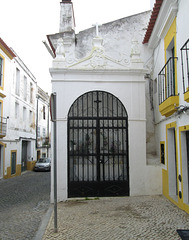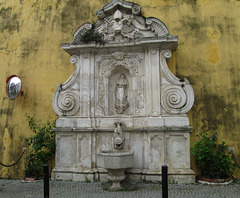Dimas Sequeira's photos
Norwegian Harley-Davidson.
| |
|
Spotted at Republic Square, Tavira.
So shiny that my reflection must be somewhere on it.
Broken bells.
| |
|
Displayed in the fenced porch at the entrance of Saint Paul Church, at Dom António Padinha Square, Tavira.
Campo Maior Castle.
Monument to Saint Beatriz da Silva.
| |
|
|
|
It stands at Quartéis Street, Campo Maior.The monument is in a place where stood her noble family house. She was born there in 1437 (her eleven brothers and sisters too) and died in 1492.
In 1976 the Vatican yielded her the statute of saint. She became the first Portuguese woman with that statute.
Saint Anthony Church.
Christmas crib.
Church of Saint John the Baptist.
Bones Chapel (18th century).
| |
|
|
|
At Dr. Regala Square, Campo Maior.
The origin of this chapel is described in the previous photo.
Bones Chapel (18th century).
| |
|
|
|
At Dr. Regala Square, Campo Maior.
In 1732 a lightning hit the powder magazine of Campo Maior Castle. This caused a major explosion, destroying half of the town, with a balance of 316 deaths and circa 2000 injuried. About 3 decades later, works were carried out in the churchyard and many human bones were found. It was decided to built a chapel in memory of the 1732 victims, with those bones covering the walls and ceiling. Those skulls and other bones had no evidences of fractures. Considering this, it's not likely they correspond to victims of the explosion - rather to people buried in the graveyard by the Mother Church, with no relation with the tragedy.
Before lunch.
| |
|
|
|
At Faisão Restaurant (faisão=pheasant), near the Mother Church, also at Dr. Regala Square, Campo Maior.
All the dishes are like this: pottery from Stoke-on-Trent.
Mother Church of Campo Maior.
Saint Anthony Church and Convent of Immaculate Con…
Oratory.
Towering view.
| |
|
|
|
From the upper terrace of the Governour's House, the highest point of Graça Fortress, UNESCO heritage. It is located near the city of Elvas. Spain is on the far background.
Look through from Graça Fortress.
| |
|
|
|
This fortress of Elvas is UNESCO heritage. It provides a far-reaching view all around. The far background is Spanish territory.
Saint Monica Fountain (19th century).
Fountain of Mercy (1650).
Esquina Gate and Chapel of Our Lady of Conception.
Jump to top
- ipernity © 2007-2025
- Help & Contact
|
Club news
|
About ipernity
|
History |
ipernity Club & Prices |
Guide of good conduct
Donate | Group guidelines | Privacy policy | Terms of use | Statutes | In memoria -
Facebook
Twitter


















